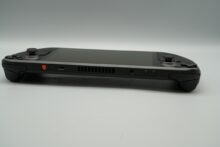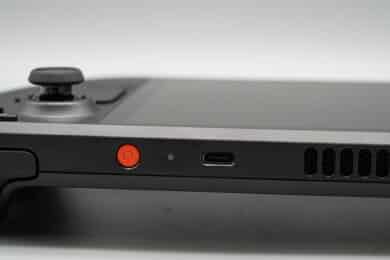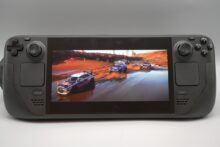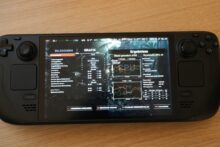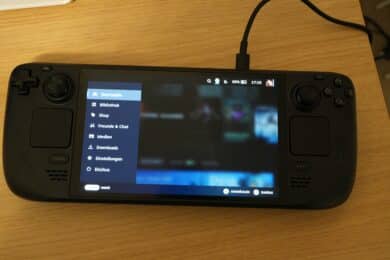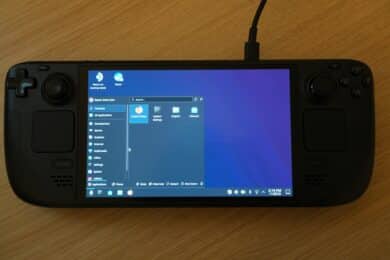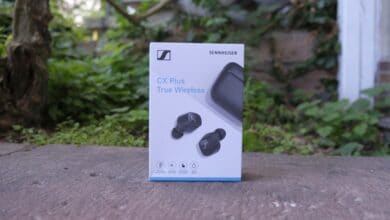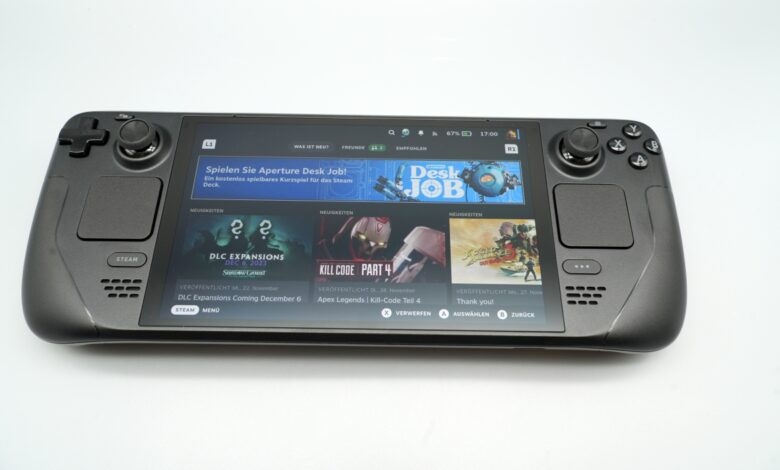
Despite its somewhat outdated hardware, Valve’s Steam Deck is still the most popular PC gaming handheld. Although Valve has repeatedly denied working on an updated version of the device, a new edition with a brighter and larger OLED panel was released in mid-November. Our Steam Deck OLED test clarifies whether it is worth buying and what the new edition has to offer.
Technical data
| The product | Steam Deck OLED |
| Display | HDR OLED with 110 percent P3 color gamut |
| Resolution | 1.280 x 800 pixels |
| Color space coverage | 110% DCI-P3; 117% sRGB |
| Screen size | 7.4 inch |
| Touch screen | Yes (180 Hertz sampling rate) |
| Refresh rate | 90 Hertz |
| Brightness | Up to 600 nits (SDR), up to 1,000 nits HDR |
| Chipset | AMD Custom APU CPU: 4x AMD Zen 2 with SMT (2.4 GHz – 3.6 GHz) GPU: AMD RDNA 2 with 8 CUs (512 shaders with 1.0 GHz – 1.6 GHz) |
| RAM | 16 GB LPDDR5 RAM (6,400 MT/s @ 128-bit) |
| System memory | 512 GB or 1 TB NVMe SSD (PCIe 3.0 x4) |
| Bluetooth | Bluetooth 5.3 (incl. aptX HD and aptX Low Latency codec) |
| Wi-Fi | WiFi 6E |
| Wi-Fi antennas | 3 |
| Audio | Louder stereo speakers with improved bass; the built-in microphone can now be used simultaneously with the headphone jack |
| Battery | 50 watt hours; faster charging (from 20 to 80 percent in 45 minutes); 2.5 meter charging cable |
| Connections | USB Type-C; 3.5 mm jack; microSD card slot |
| Dimensions | 298 mm x 117 mm x 49 mm |
| Weight | 639 grams |
| Price | 569.00 Euro (512 GB memory) 679.00 Euro (1 TB memory) |
Steam Deck OLED test: Scope of delivery, design and workmanship
- simple and high-quality design
- excellent operability
- impeccable workmanship
In purely visual terms, not much has changed on the Steam Deck OLED compared to its LCD predecessor. At least at first glance. The dimensions of 298 mm x 117 mm x 49 mm have remained the same, but the weight has been reduced from 670 grams to 640 grams.
The front is still dominated by the display, which now not only relies on OLED technology, but has also grown from 7 inches to 7.4 inches. It is still framed by the two analog sticks, touchpads, buttons and speakers.
The surface of the sticks has also been redesigned and now has a better grip – similar to the rest of the casing. At the same time, the sticks and touchpads should now work a little more precisely and be able to recognize inputs more accurately.
Small detail: The screws have been simplified and replaced by Torx screws for the most part, which – in addition to further adjustments on the inside – should make it easier to repair.
The power button on the top has now been given an orange color, which distinguishes the OLED model from its predecessor. Here we also find the USB-C port, air outlet, the 3.5 mm jack socket for headphones, the two volume buttons and the R1 and L1 bumpers as well as R2 and L2 triggers.
At the bottom, the Steam Deck OLED has a microSD card slot for memory expansion, while there are four additional buttons on the back. So not much has changed in terms of design, but the OLED model still looks a little more robust and valuable. The build quality is still extremely high, making the PC gaming handheld look as if it has been cast from a single mold.
Steam Deck OLED test: The new display is the star
- colorful and high-contrast OLED panel
- 90 Hz; up to 1,000 nits
- increased touch sampling rate of 180 Hz
The most important innovation and sar of the show with the Steam Deck OLED is of course the display. Valve is retiring the old LCD panel and replacing it with a new OLED screen, which is ahead in all respects, and in some cases significantly so.
As already mentioned, the screen diagonal has increased from 7 inches to 7.4 inches. However, the manufacturer has not made any changes to the resolution, which is still 1,280 x 800 pixels. However, the refresh rate (90 Hz instead of 60 Hz) and the brightness have been increased, sometimes significantly.
The Steam Deck OLED achieves a typical brightness of 600 cd/m² (compared to 350 cd/m² for the LCD version), with a peak brightness of a whopping 1,000 cd/m² – more than twice as much as its predecessor.
In typical OLED fashion, the new screen scores accordingly with deep black tones, where the first edition of the handheld still had to contend with sometimes very visible light levels. The colors are also much richer, covering 100% of the DCI-P3 color space and 63.7% of the sRGB color space – also around twice as much as the original Steam Deck.
This makes for an even more beautiful and intense gaming experience, which also benefits from a further improvement. Valve has also adjusted the sampling rate of the touchscreen, which now responds much more smoothly at 180 Hz (compared to 120 Hz).
While the original Steam Deck already offered a good, but by no means outstanding display, it is now finally catching up with the competition and sometimes even surpassing it. An ASUS ROG Ally, for example, offers a higher resolution, but only uses IPS and is not as bright as the new OLED edition.
Playing on the Steam Deck is a pleasure. Even more demanding triple-A games such as Elden Ring or Diablo 4 are shown to their best advantage on the screen, although of course the same HDR results are not achieved here as on a corresponding TV or gaming monitor – that should be clear to everyone.
Features and hardware
- CPU in the more energy-efficient 6 nm process
- faster RAM
- many improvements such as Wi-Fi 6E and larger battery
There have also been some changes to the features of the Steam Deck OLED. The improvements, which the manufacturer had not communicated at all, are somewhat surprising.
Although it still uses an AMD Zen 2 CPU with four cores and clock speeds of 2.4 GHz to 3.5 GHz, it has now been manufactured using the 6-nanometer process and is therefore noticeably more energy-efficient (but more on this later).
The GPU, on the other hand, has not changed. An AMD RDNA 2 GPU with 8 compute units and clock rates of 1.0 GHZ to 1.6 GHz is used as the graphics processor, which is supported by 16 GB of LPDDR5 RAM. However, this now clocks at 6,400 MT/s instead of 5,500 MT/s.
The removable NVMe SSD, available in either 512 GB or 1 TB, is connected via PCIe 3.0 x4. Valve has also worked on the other features of the OLED model, including the following improvements and innovations:
- Faster Wi-Fi 6E (instead of Wi-Fi 5)
- 3 Wi-Fi antennas for better connections (instead of 2)
- Bluetooth 5.3 incl. support for aptX HD and aptX (instead of Bluetooth 5.0)
- Improved speakers with more bass and clearer treble
- Battery capacity: 50 watt hours (instead of 40 Wh)
- New quick charge function
- Revised cooling system with larger fan
A whole range of improvements that Valve has paid for with an additional 100 euros when comparing the old Steam Deck and the OLED version with 512 GB system memory. In our eyes, however, these 100 euros are well invested, as the Steam Deck OLED is ahead in almost all respects.
Battery life, cooling and volume
- 3 to 12 hours runtime (depending on game, settings and brightness)
The battery in the Steam Deck OLED has therefore increased slightly. However, in conjunction with the more efficient chip, the gaming handheld benefits noticeably from the improvements. And across the board.
The manufacturer promises around an hour more playing time with triple-A titles, which we can confirm in practice. Of course, the runtime depends heavily on usage behavior, the graphics settings and the brightness setting.
Demanding games such as Diablo 4 or Elden Ring achieve a runtime of 2 hours and 20 minutes and 2 hours and 37 minutes respectively with 90% display brightness and activated HDR, which is actually a noticeable increase compared to the LCD Steam Deck (1 hour and 40 minutes / 1 hour and 58 minutes).
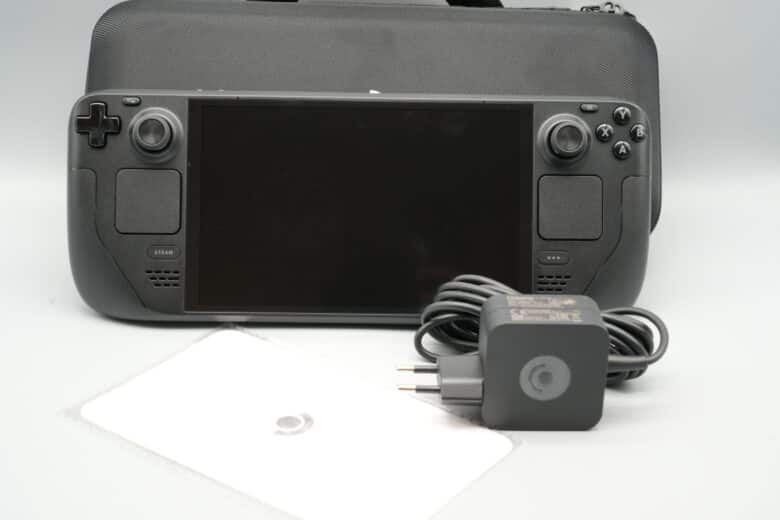
With less demanding games or reduced brightness, deactivation of HDR and adjustment of the graphics settings, significantly longer runtimes are of course possible – Valve promises up to 12 hours of continuous use.
The Steam Deck OLED is therefore not an endurance miracle either, but a significant improvement in battery life is clearly noticeable. Of course, a competitor like the Razer Edge (our test) is clearly ahead here, but it doesn’t have to face comparably demanding tasks with mobile games and game streaming.
Improved cooling system
- noticeably improved cooling
- slightly quieter fan
The handheld’s cooling system has also improved, keeping the heat development of the device noticeably better in check. Both the rear of the casing and the interior in the form of the CPU and GPU are cooled noticeably more effectively – we measured up to 10 degrees Celsius lower values here.
The rear in particular, where the hands are located, is significantly cooler than the LCD version. This is where the biggest improvement in heat dissipation can be seen. This means that the OLED model can be used for several hours without any problems and without getting uncomfortably warm.
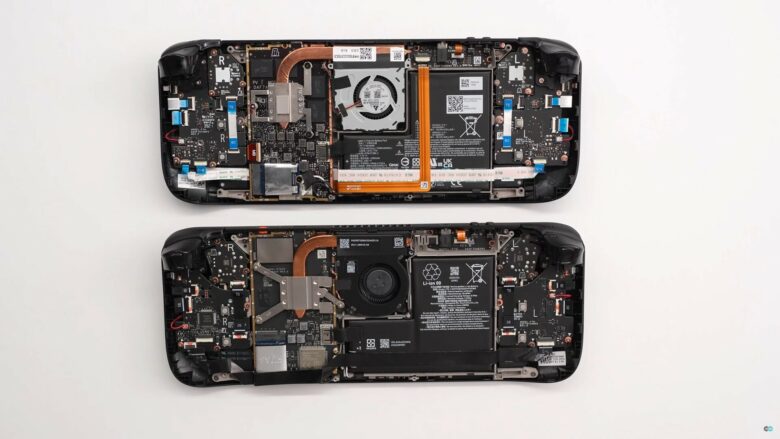
Under load, the Steam Deck OLED is also around 3 decibels quieter than its predecessor. A minimal improvement that is hardly noticeable in practice. But of course we don’t want to complain either.
Gaming and practical test
- higher or at least the same performance as the LCD model
- fairly large game catalog
- pleasantly grippy handling
There is no question that the original Steam Deck was already an excellent handheld that won many fans not only thanks to its impeccable SteamOS optimization, but also with its impressive gaming performance.
All of this is of course also available in the Steam Deck OLED, although the titles are more vivid, more colorful and much prettier to look at thanks to the new display. At the same time, the new surface of the screen also prevents reflections much better, which ensures better readability in bright environments or under direct sunlight.
In terms of performance, the more effective cooling and an 11% increase in memory bandwidth promise slightly better gaming performance. Depending on the title, this is more or less the case.
Depending on the game, we achieved frame rates in the test that were on average between 2 FPS and 5 FPS above the values of the Steam Deck LCD. Although this is not much, there were no games in which the OLED version performed the same or worse than its predecessor.
At the same time, the Steam Deck OLED manages to maintain a more constant frame rate with less stuttering in demanding games. The input lag has also been minimally improved. So although there is no really noticeable increase in performance, the optimizations result in a smoother and generally better gaming experience.
The pure gaming experience of the Steam Deck OLED is largely similar to that of the previous model. Personally, I find that the handheld is very comfortable to hold despite its sheer size – and I have small to medium-sized hands.
Operation and games
All buttons, bumpers and triggers are easy to reach and score points with impeccable feedback, which is sometimes even confirmed haptically.
When it comes to games, it is of course important to make sure that they are compatible with the handheld – the range of games has of course increased significantly since the launch. 2.according to the store, there are currently 211 titles optimized for the Steam Deck that are fully adapted for the handheld.
There are also many other titles that are not fully optimized but can still be played. The gaming experience varies considerably from time to time. However, the verified and tested games in particular run flawlessly and offer a console-like experience.
If you prefer, you can of course also play the games with a controller or even a mouse and keyboard. And with games such as Cyberpunk 2077, Diablo 4, Forza Horizon 5 or God of War, the PC gaming handheld is of course in a completely different league to a Nintendo Switch OLED, for example.
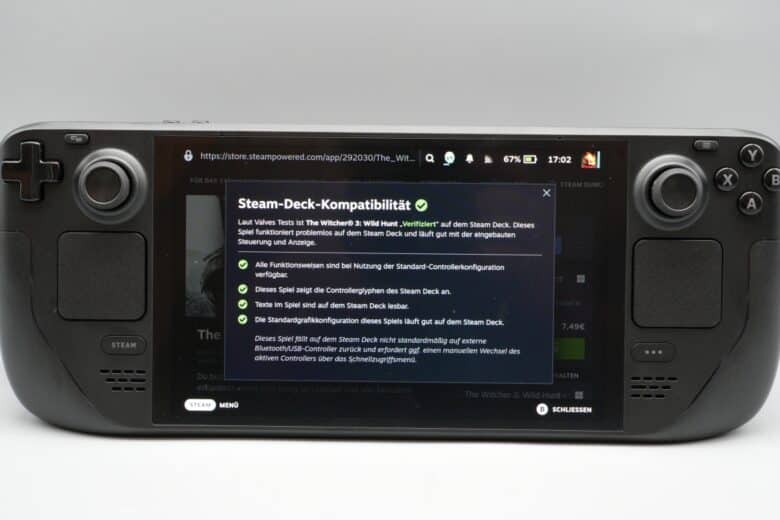
Unlike the ASUS ROG Ally or Lenovo Legion Go, you are of course limited to games in the Steam store, while the competitors also play titles from other stores such as Epic Games Store or Ubisoft.
The selection is therefore not quite as broad, but the Steam Deck still offers the most fluid and intuitive user interface, providing convenient and reliable navigation without having to navigate through a Windows 11 user interface on the small display.
Steam OS 3.5
Of course, what is more important to you depends on your personal taste and preferences. The Steam Deck OLED also offers a desktop mode. Here, the handheld behaves almost like a classic notebook – albeit with a limited range of functions. But it is certainly useful as an emergency solution.
I also find myself playing completely different games on the Steam Deck than I would on my gaming PC. Some older titles or indie hits are much more fun on the handheld, lying comfortably on the sofa, than sitting at the PC.
In my time with the device, I’ve dug out some older gems and learned to love them all over again. But current games such as Shadow Gambit or Diablo 4 are also very enjoyable to play on the handheld.
Steam Deck OLED test: Conclusion
The Steam Deck OLED is a welcome upgrade for the handheld, which has already positioned itself as the top dog in its segment since its release in February 2022.
The biggest and most important innovation is undoubtedly the new display, which with its high brightness, OLED-typical advantages such as deep black and rich colors or the additional protection against reflections alone is a selling point.
The fact that the refresh rate has also been increased to 90 Hz is more than just a nice bonus. In combination with the increased touch sampling rate, this noticeably improves the gaming experience.
There are also many other improvements, some of which are hidden. From the fast WLAN to the larger battery and the more efficient chip, which even provides slightly more power, the result is an all-round coherent overall package for the same price as the LCD model (or optionally with more memory).
Combined with the impeccable user interface and ease of use, the Steam Deck OLED secures the top spot in the PC gaming handheld segment. Unfortunately, only owners of the original are left out in the cold, leaving a slightly bitter aftertaste.
Steam Deck OLED
Design & workmanship
Hardware
Display
Performance
Battery
Value for money
93/100
A significantly better display, slightly better performance, more effective cooling and many other innovations make the Steam Deck OLED a welcome upgrade. The overall package makes it the best PC gaming handheld currently on the market, even though some of its competitors offer slightly better performance.

